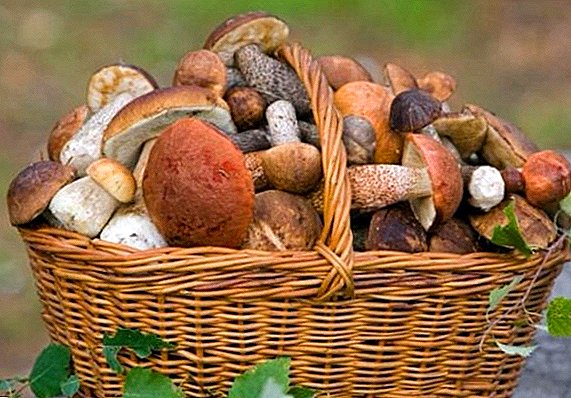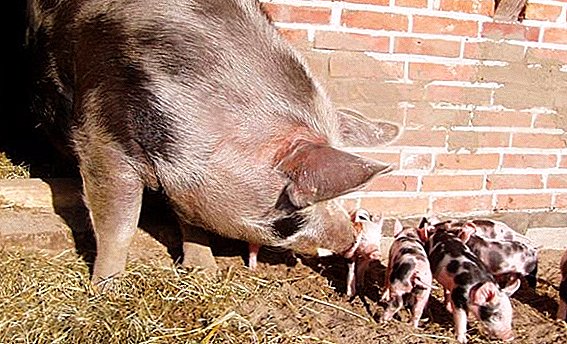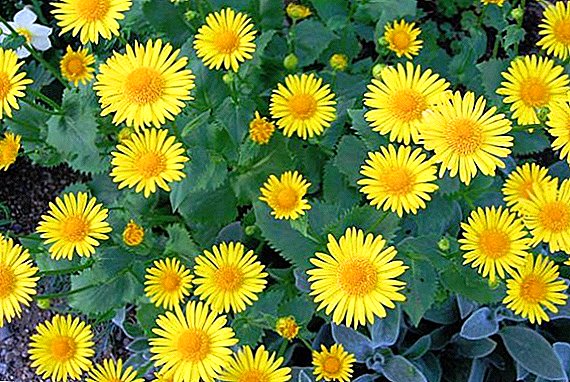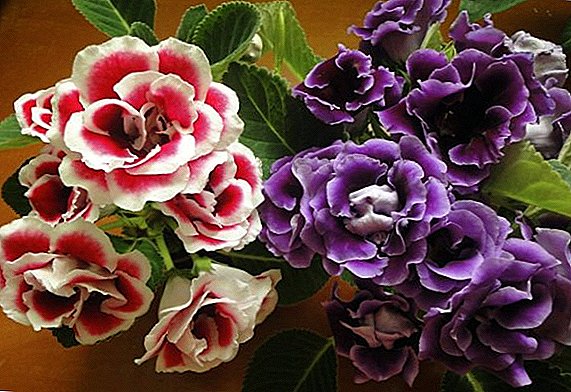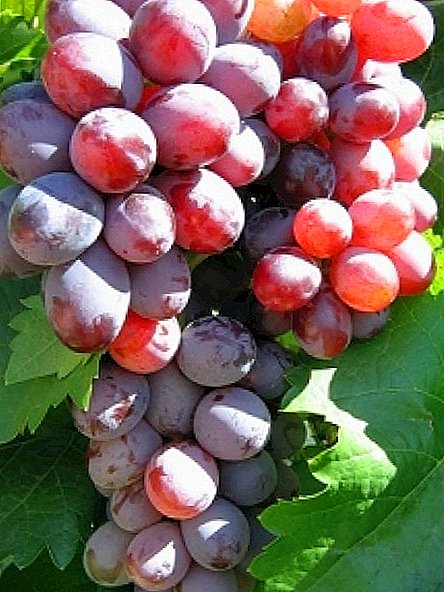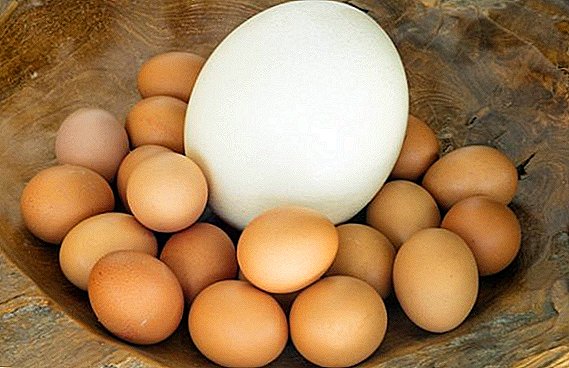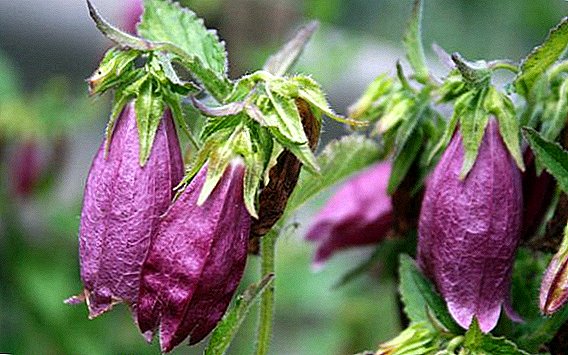 Decorating the area near the house, pay attention to the unpretentious bells. These interesting, delicate and bright flowers seemed to come from a fairy tale. From the first summer month they are densely covered with buds and retain flowering until mid-autumn. How to grow bells point, as well as how to care for a flower garden, we will tell further.
Decorating the area near the house, pay attention to the unpretentious bells. These interesting, delicate and bright flowers seemed to come from a fairy tale. From the first summer month they are densely covered with buds and retain flowering until mid-autumn. How to grow bells point, as well as how to care for a flower garden, we will tell further.
Botanical description
Point bell refers to perennial plants of the bell type. It has an erect, lowered stem of 30-50 cm in height. The leaves are elliptical, lowered. On peduncles during flowering forms large (up to 4 cm) drooping flowers.
Did you know? People call bells cinella bells, bells, chebots or pichuzhnitsami.Varieties of bells, there are more than three hundred. They have different colors not only of the petals, but also of the leaves. Fruits in September and October. The period depends on weather conditions. The dotted bell has superiority over many of its fellows: it begins to bloom in early summer and pleases the eye until the frost.
 The name of the plant was due to crimson specks on white petals, visible inside the inflorescence. It has a flower and a special shape - an inflated keg that converges to the blade-petals. The bellflower inflorescence consists of 5 petals connected in a corolla. At the foot of the flower there is a border of 10 green teeth, 5 of which are raised up, and the rest are looking down.
The name of the plant was due to crimson specks on white petals, visible inside the inflorescence. It has a flower and a special shape - an inflated keg that converges to the blade-petals. The bellflower inflorescence consists of 5 petals connected in a corolla. At the foot of the flower there is a border of 10 green teeth, 5 of which are raised up, and the rest are looking down.Distribution and habitat
Homeland bell point is the eastern region: Japan, China, Korea. It is also found in Eastern Russia. Natural place of growth - river banks, birch and valley forests.
Check out the list of the most popular bells.
Popular varieties of bell point
This plant has several dozen (according to some sources - more than one hundred) varieties. But the most popular are:
- "Garland". Rises to 40 cm. Flowers - large, oblong, gathered in a panicle. There are pink and dark colors with purple dots. The branches and leaves are gray-green. Begins to bloom in June;

- "Pink-Red". The height of the stems is 50 cm. On the stems of red tint pubescent leaves are attached. Flowers - large (up to 8 cm), goblet-shaped, formed in panicles. The flowering period is June-August. Growing rapidly;

- "Alba Nana". Compact shrub with pale-striped milk flowers. Leaves are light green, oval;

- Ash Sensation. Medium height (up to 50 cm) plant with small glossy, dark green leaves. Flowers - medium, goblet. Flowering time - June-August;

- Silver Bells. Medium (up to 40 cm) shrub with a powerful, rapidly expanding rhizome. Heart-shaped, visible leaves are scattered on erect stems. Flowers - large (about 7 cm), pearl-pink with carmine specks, have the shape of a glass. All summer bloom;

- "Pantaluns". Medium size plant up to 50 cm. Main characteristic - it blooms with large double goblet flowers of lilac-pink color. Leaves - medium, green, smooth. Variety tolerates frost. It blooms during the summer;

- "Hot Lips". Low-growing (up to 30 cm) variety with large, dangling, pale pink flowers, studded with brown cannabis. Leaves - medium, oval, spiky, with dark veins. Frost-resistant

Important! Some varieties are capricious. In different conditions, the same species can grow terry or normal.
Use in landscape design
Bells will decorate the shady places of the site, as well as serve as a magnificent decor for reservoirs or landings along the fences. Particularly charming these plants look on the stones in the alpine hills. Experts advise to plant flowers in mixborders or in single plantings at the foot of the trees. Successfully used plants and landscaping of the city. Their flowering does not leave indifferent, and the flower beds become variegated and alive.
Learn how to plant and grow bells in your summer cottage.
Growing at home
Cultivation of the bell on the garden plots is not a problem - even the most delicate varieties easily adapt to their surroundings. But large, decorative, long-flowering plants still require some care. The flower will have the appropriate appearance only under optimal conditions in which perennial bells are grown. 
Conditions of detention
Bells grow well in the shade, but more prefer well-lit places. When choosing a place you need to take into account the fact that the bushes are growing - they need space. An ideal place to plant a flower is a hill or other hill where moisture can easily go away. The bell does not tolerate stagnation of water, its roots can deteriorate, and freeze in winter.
Did you know? The flowers and fruits of bluebells are always directed downwards. This is not just the case - the plant thus protects nectar and seeds from rain.
Soil and fertilizer
Land for bells should be loose, slightly alkaline or neutral, well drained. To reduce acidity and increase aeration, humus, peat, and turf soil are added to loamy or clayey soil.  In the spring, the soil is fertilized with nitrogen fertilizer, promoting the rapid growth of greenery, wood ash or manure. In the summer they use complex fertilizing, and in the fall they fertilize with potassium, which helps the plant to cope with the cold.
In the spring, the soil is fertilized with nitrogen fertilizer, promoting the rapid growth of greenery, wood ash or manure. In the summer they use complex fertilizing, and in the fall they fertilize with potassium, which helps the plant to cope with the cold.
Watering and moisture
Watering bells are indifferent. They need additional moisture only during the formation of buds and in hot, dry weather. Irrigation is done at the root. At the same time make sure that water does not fall on the leaves and flowers. If rainy weather sets in, then water should be monitored. Therefore, it is recommended to periodically loosen the soil and remove weeds so that the soil is well aerated.
Read also about how to grow a bell peach, broadleaf, Carpathian and Pozharsky bell.
Breeding
The bells can be propagated either with the help of seeds or by dividing a bush (vegetatively). Both techniques are quite popular and are used successfully by gardeners.
Seeds
Seed material does not require prior preparation. It can be sown directly into the soil. Landing is carried out in May, when the ground is well warmed, or for the winter, in October. For planting in unprotected soil prepare the soil: loosen and moisturize. For seeds, shallow beds are prepared, spread seed there and sprinkled with a small layer of sand. The first shoots will appear in 14-17 days.  When the seedlings take root a little, the thick places thin out. After a time, after the appearance of the third true leaf, seedlings can be swooped down. In order for the bells to bloom in the current year, they need to be planted in March for seedlings. Due to the fact that the seeds of the plant are small, they are laid out on the surface of a pre-moistened soil mixture, which meets the following parameters:
When the seedlings take root a little, the thick places thin out. After a time, after the appearance of the third true leaf, seedlings can be swooped down. In order for the bells to bloom in the current year, they need to be planted in March for seedlings. Due to the fact that the seeds of the plant are small, they are laid out on the surface of a pre-moistened soil mixture, which meets the following parameters:
- easy;
- loose;
- permeable.
Important! When planting seeds do not apply fertilizer to the soil.The scattered material is lightly pressed to the substrate, sprayed with water and covered with a film. So at a temperature of + 18 ... +20 ° C hold up to planting in open ground. Sprouts make their way through 14-20 days. After sprouting has sprung up, the container is moved to a bright place (without direct sunlight), the film is removed and taken care of as any seedlings:
- water as the soil dries;
- loosen the soil.

Vegetative
With this method of reproduction, the maternal properties of the plant and hereditary traits are preserved. This is especially valuable for plant varieties whose seeds do not have time to mature.
Important! When dividing, you need to take only rooted bushes.The plant must be at least 3-5 years old. Although some varieties can be divided already in the first year of life. The time of vegetative propagation is the beginning of May or the end of August. The process of vegetative propagation is not complicated: the mother plant is dug out, the seedlings of the aerial part are cut and the root system is separated.
 Each part should have a separate root system and kidneys for further renewal. The resulting delenki planted in the wells so that the kidney for recovery remained on the surface.
Each part should have a separate root system and kidneys for further renewal. The resulting delenki planted in the wells so that the kidney for recovery remained on the surface.Relation to temperature
Most of the varieties are frost-resistant and tolerate winter without shelter, but in the northern regions it is advisable to cover the plants with a dry foliage layer of 15-20 cm.
Possible difficulties in growing
Brightness and diversity are not the only virtues of bells. They are so undemanding that growing and caring for them will not only take away a lot of time and effort, but also bring pleasure.
We study the features of planting flowers in a flower bed.
One need only take into account some points:
- in order for the bell to enjoy its flowering longer, you should timely remove faded buds;
- by the middle of autumn the dotted bell stops blooming and leaves foliage. At this time, the seeds are collected for future seedlings and cut off the upper part, and the ground is covered with spruce leaves, dry leaves, sawdust or peat;
- the roots of the bellflower grow rapidly. Therefore, to prevent sprawling into neighboring areas, plastic or metal tapes are buried in the ground.

Pests, diseases and prevention
The greatest danger to the bellflower is represented by the tick, whitefly, scutes, slugs, slobbering pennits and mealybugs. And in case of excess moisture, gray mold occurs. They fight with them either with folk remedies (broth of bitter pepper, tincture of garlic, etc.), or insecticides.
Important! In general, the bell is resistant to most diseases. Problems in cultivation may result from illiterate care.To prevent diseases, a plant twice a year must be treated for parasites (for example, "Fundazole"). In addition, if the bell grows in one place for more than five years, harmful microorganisms accumulate in the soil, which, after hitting the roots, can destroy the whole plant.
Your garden will be beautifully decorated with such herbaceous plants as tricolor violet, Black Root, Penstemon, Thyme darmer, bookfoot, Euphorbia cypress, solarium, Sharogolovy mordovnik, forest forget-me-not, Pentas and licoris.In this case, the soil is recommended twice a year to treat antifungal products. Following these uncomplicated rules, anyone can grow on his site different varieties of bell point. And during the flowering of the flower bed or hill will turn into a magnificent bright cloud.
Video: dotted bell
Reviews from the network












